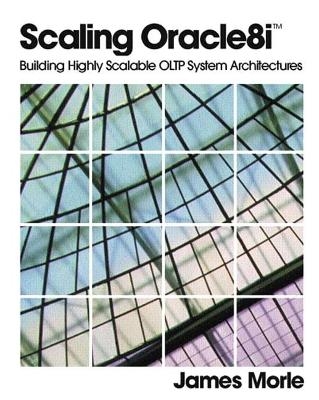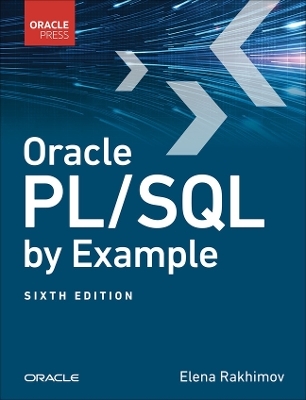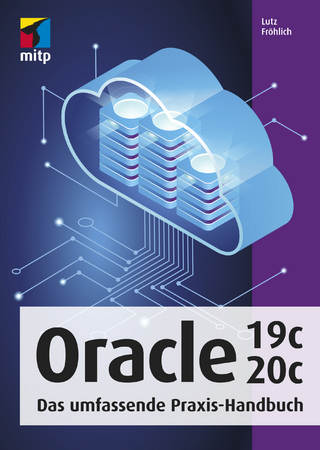
Scaling Oracle8i™
Addison Wesley (Verlag)
978-0-201-32574-4 (ISBN)
This is the complete, expert guide to building enterprise-class UNIX-based Oracle OLTP systems that deliver maximum performance and scalability. In Scaling Oracle 8i, one of the world's leading Oracle consultants introduces today's best methods and technologies for building industrial-strength Oracle database systems on UNIX platforms. Understand exactly what scalability means in the enterprise; then discover how to deliver it, step-by-step, from the ground up, through design, testing, construction, maintenance, benchmarking, and ongoing management. Morle covers every component that impacts performance, including hashing, caching, hardware architecture and I/O subsystems, Oracle database objects, data storage, memory structures, and a detailed review of the Oracle Parallel Server. Readers will find comprehensive coverage of tuning the underlying UNIX platform to improve OLTP response times; including co-engineering the kernel; working with virtual memory, I/O, interprocess communication; and more. Scaling Oracle 8i contains a full chapter on the special issues associated with e-commerce, as well as a detailed case study drawn from one of the world's largest car rental reservations systems. For all enterprise system architects, database engineers, and application developers working with Oracle.
James Morle runs a specialist consulting company, Scale Abilities, that specializes in solving complex technical and architectural problems for leading companies. He has built a number of the world's largest and most challenging systems, including one of the first large Oracle Parallel Server systems. Specializing in high-performance scalable systems, his background is in Oracle and UNIX internals. He can be contacted directly at James.Morle@Scaleabilities.co.uk. 0201325748AB04062001
Figure List.
Preface.
Introduction.
I. CONCEPTS AND ARCHITECTURE.
1. Scaling Concepts.
What Is Scaling?
Speedup.
Concurrency (Scaleup).
Latches and Locks.
Why Lock?
Things That Need Locking/Latching.
Waiting on Latches and Locks.
Design Considerations to Reduce Lock Contention.
Linked Lists.
What Is a Linked List?
What Are Linked Lists Used For?
Optimizing Chain Lengths.
Hashing.
What Is Hashing?
Caching.
Cache Fundamentals.
Memory Hierarchies.
Cache Reference Patterns.
I/O Caching.
CPU Cache Concepts.
Chapter Summary.
Further Reading.
2. Hardware Architectures and I/O Subsystems.
Introduction to Hardware Architectures.
System Interconnects.
Bus Architecture.
Direct Memory Access (DMA).
Cache Coherency.
Single Processor Architectures (Uniprocessors).
Advantages.
Oracle on Uniprocessors.
Other Disadvantages.
Summary.
Symmetric Multiprocessors (SMPs).
SMP Advantages.
Kernel Challenges.
Oracle on SMP Architectures.
Shared-Bus Limitations.
Summary.
Point-to-Point SMP.
Cache Coherency.
Summary.
Clustered SMP.
Clustering Types.
Summary.
Massively Parallel Processors (MPPs).
Definition.
Oracle on MPP Systems.
Summary.
Cache Coherent Nonuniform Memory Access (ccNUMA).
Definition.
Sequent NUMA-Q 20.
SGI Origin 20.
Oracle on NUMA Systems.
Summary.
Storage Systems.
I/O Busses.
Controllers.
Disk Drives.
Disk Drive Sizing.
Redundancy.
RAID Levels.
RAID-5.
Cached Disk Arrays: EMC Symmetrix.
Chapter Summary.
Further Reading.
II. BUILDING SUPPORT SOFTWARE.
3. Benchmark Concepts and Design.
Why Develop a Benchmark?
Capacity Planning.
Upgrades.
Platform Changes.
What Are We Simulating?
Defining Application Areas.
Defining the Application Split.
Careful with Those Assumptions, Eugene.
Selecting a Development Approach.
Using Remote Terminal Emulation Software.
Custom Simulation Development.
Building a Simulator Using RTE Software.
Building a Custom Benchmark Suite.
Programming Environment.
When the Application Has Not Been Written.
If the Application Exists: Trap and Emulate All SQL Calls.
Using Tracefiles to Generate a Simulation: An Introduction to dbaman.
Validate Server-Side System Utilization.
Building a Multiuser Framework.
Scale the Simulator.
Data Problems.
User Control Problems.
Simpler Methods for Use with dbaman.
Make It Easy to Run.
Portability.
Packaging.
Start-Up Scripts.
Automating Information Retrieval at Closedown.
Define Limitations in Advance.
A Benchmark Is Never Perfect.
Measure the Impact of the Inaccuracies.
Chapter Summary.
Further Reading.
4. System/Database Monitoring.
Why Monitor?
Proactive Fault Detection.
Rapid Fault Diagnosis.
Historical Performance Records.
Low-Intrusion Techniques.
Go Easy on the System.
Avoiding Single-Threaded Resources.
Introduction to V$ Views.
What Are the V$ Views ?
Accessing the V$ Views.
Structure of the V$ Views.
Overhead of Using V$ Views.
Minimizing Overhead.
Using dbaman to Optimize Data Collection.
Defining the Cursors.
Parsing and Executing the SQL.
Process the Result Sets.
Pulling it Together with a Main Loop.
Processing Statistics.
Data Transports.
Alarm Propagation.
Defining the "Flight Envelope."
What Is a "Flight Envelope"?
How Do I Define a Flight Envelope for the System?
Using Excel Spreadsheets for Data Visualization.
Chapter Summary.
III. HOW ORACLE WORKS.
5. Physical Oracle.
Introduction.
Overview.
Control Files.
Datafile Information.
Operating Information.
Redo Log Information.
Log History.
Backup Information.
The INIT.ORA File.
Rules for init.ora Creation.
Data Storage.
Overview: The Physical Picture.
Blocks: An Introduction.
Block Cleanout.
Redo Logfiles.
Key Database Objects.
Rollback Segments.
Read-Only Tablespaces.
Temporary Tablespaces and Temporary Segments.
Tables.
Indexes.
Other Database Objects.
The Data Dictionary.
Chapter Summary.
Further Reading.
6. Oracle8 in Operation.
Introduction.
The Oracle Kernel.
Process Architecture.
Shadow Processes.
Net8.
The SGA Components.
High-Level View.
Fixed Region.
Variable Region.
Buffer Cache.
Operation of the Buffer Cache.
Introduction.
Hash Chains.
LRU Chains.
Latch Coverage.
CR Versions.
DBWR Operation.
Flowchart Summary of Buffer Cache Operation.
Shared Pool Structure.
Shared Pool: The Library Cache.
Introduction.
Cursors.
The Parsing Mechanism.
Latch Coverage.
Other Memory Structures.
Dictionary Cache.
Log Buffer.
Oracle Parallel Server Concepts
Introduction.
Distributed Lock Manager (DLM).
Parallel Cache Management.
Design Considerations for OPS.
Summary.
Further Reading for OPS.
V$ Views Exposed.
Session-Level Information.
V$SESSION_EVENT.
.System-Level Information.
Chapter Summary.
Further Reading.
IV. HOW UNIX WORKS.
7. Introduction to UNIX.
What Is a Kernel?
"That Picture."
Execution Modes.
Explicit Kernel Processing (Process Context Kernel Mode).
Implicit Kernel Processing (System Context Kernel Mode).
Processes.
The Process "Table."
Process Scheduling.
Signals.
Process Lifecycle.
Memory Management: The Virtual Memory System.
Introduction.
Virtual Memory Introduction.
Virtual Memory Hierarchy.
The Memory/Disk Hierarchy.
Implementing the Hierarchy.
Implications of fork() and exec().
Summary.
I/O System.
Everything Is a File.
Filesystems.
Raw Disk.
Filesystems Versus Raw Disk.
Logical Volume Managers.
Interprocess Communication (IPC).
Pipe Communication.
System V IPC.
More on System Calls.
Chapter Summary.
Further Reading.
8. Oracle User's Guide to UNIX.
Coengineering the Oracle Kernel.
VOS Responsibilities.
Vendor Coengineering.
UNIX Tools.
top.
Tcl and expect.
Korn Shell.
awk.
Further Reading
V. IMPLEMENTING ORACLE.
9. Scalable Transaction Processing.
Scalable Applications.
Application Design.
Scalable SQL.
Transac. 0201325705T04062001
| Erscheint lt. Verlag | 7.1.2000 |
|---|---|
| Verlagsort | Harlow |
| Sprache | englisch |
| Maße | 233 x 185 mm |
| Gewicht | 866 g |
| Themenwelt | Mathematik / Informatik ► Informatik ► Betriebssysteme / Server |
| Informatik ► Datenbanken ► Oracle | |
| Mathematik / Informatik ► Informatik ► Theorie / Studium | |
| ISBN-10 | 0-201-32574-8 / 0201325748 |
| ISBN-13 | 978-0-201-32574-4 / 9780201325744 |
| Zustand | Neuware |
| Haben Sie eine Frage zum Produkt? |
aus dem Bereich


